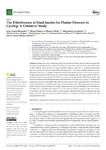The Effectiveness of Hard Insoles for Plantar Pressure in Cycling: A Crossover Study

Use este enlace para citar
http://hdl.handle.net/2183/34620Colecciones
- Investigación (FEP) [507]
Metadatos
Mostrar el registro completo del ítemTítulo
The Effectiveness of Hard Insoles for Plantar Pressure in Cycling: A Crossover StudyAutor(es)
Fecha
2023-07-08Cita bibliográfica
Casado-Hernández, I.; Becerro-de-Bengoa-Vallejo, R.; Losa-Iglesias, M.E.; Soriano-Medrano, A.; López-López, D.; Navarro-Flores, E.; Pérez-Boal, E.; Martínez-Jiménez, E.M. The Effectiveness of Hard Insoles for Plantar Pressure in Cycling: A Crossover Study. Bioengineering 2023, 10, 816. https://doi.org/10.3390/ bioengineering10070816
Resumen
[Abstract] Background: Hard insoles have been proposed to decrease plantar pressure and prevent
foot pain and paresthesia due to repetitive loading. The aim of this research was to analyze the effect
of three different hard insoles in cycling on healthy subjects. Methods: A crossover randomized
trial was carried out. The mean age of the subjects was 35 3.19 years, and all of them were men.
While the subjects were cycling on a stationary bicycle, their plantar pressure was recorded with nine
in-shoe sensors placed in nine specific foot areas to test a standard ethylene-vinyl-acetate 52 Shore A
hardness insole, a polypropylene 58 Shore D insole, and a polypropylene 580 Shore D insole with
selective aluminum 60 HB Brinell hardness in the metatarsal head and hallux. Results: The maximum
plantar pressure decreased significantly with the polypropylene insole containing selective aluminum
in the metatarsal head and hallux areas. The maximum plantar data of the polypropylene aluminum
insole in the M2 area (5.56 kgF/cm2), fifth metatarsal styloid process (6.48 kgF/cm2), M3–M4 area
(4.97 kgF/cm2), and hallux (8.91 kgF/cm2) were of particular interest compared to the other insoles.
Conclusions: The use of insoles made of polypropylene with aluminum in the metatarsal head and
hallux areas decreases the maximum plantar pressure in cycling compared to standard EVA and
polypropylene insoles.
Palabras clave
Cycling
Plantar pressure
Foot insole
Metatarsal head
In-shoe
Ciclismo
Presión plantar
Plantilla
Cabeza del metatarso
Parte interna del calzado
Plantar pressure
Foot insole
Metatarsal head
In-shoe
Ciclismo
Presión plantar
Plantilla
Cabeza del metatarso
Parte interna del calzado
Versión del editor
Derechos
Atribución 3.0 España






